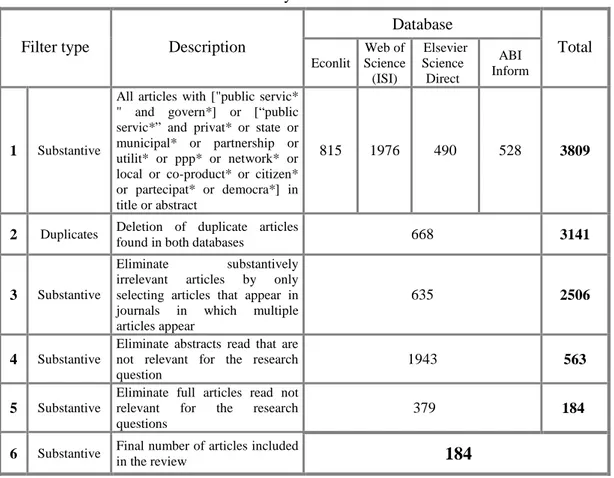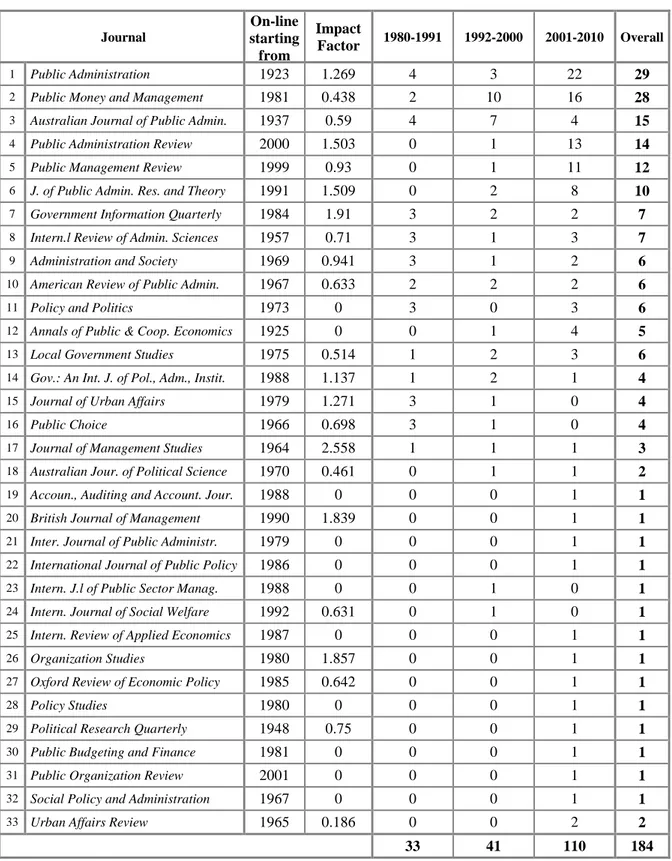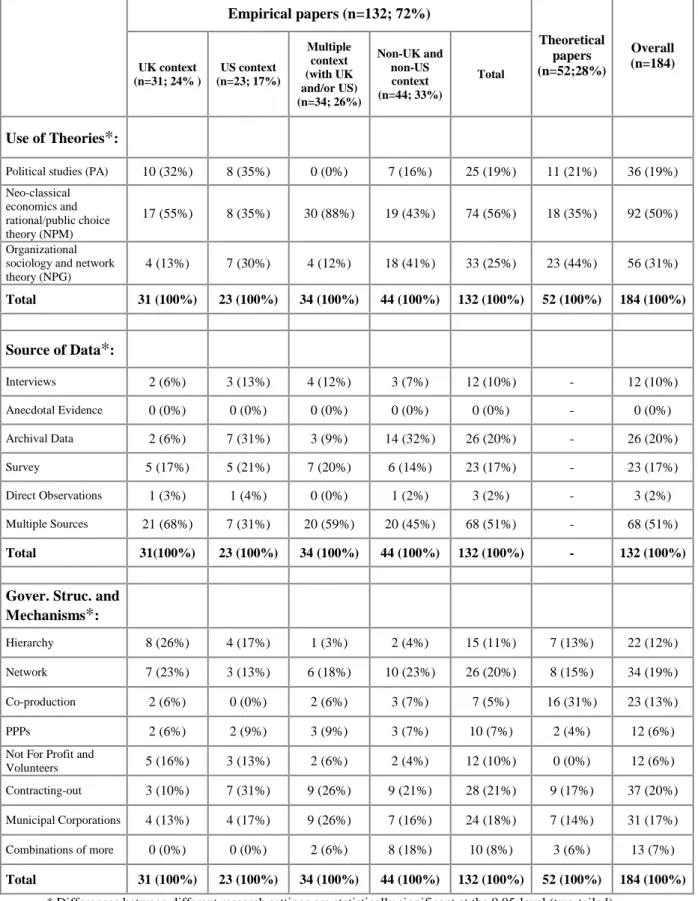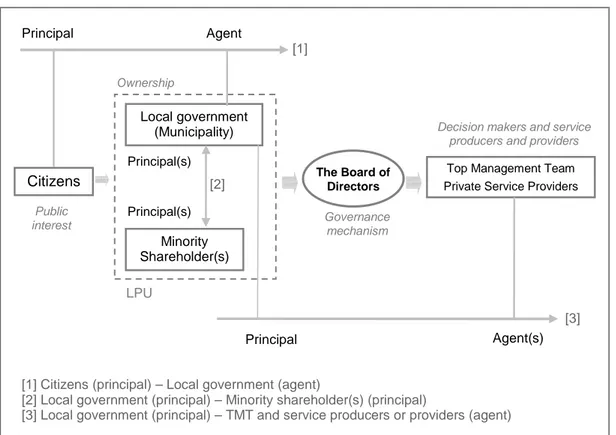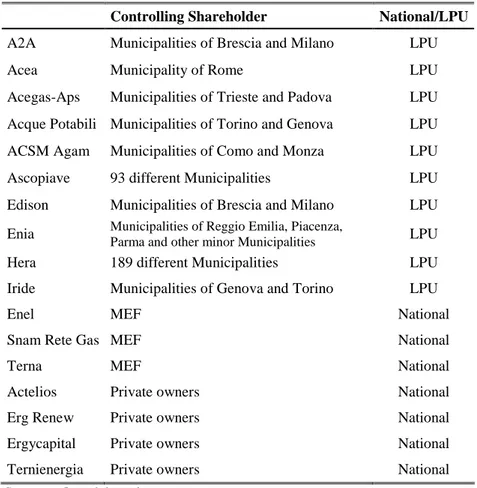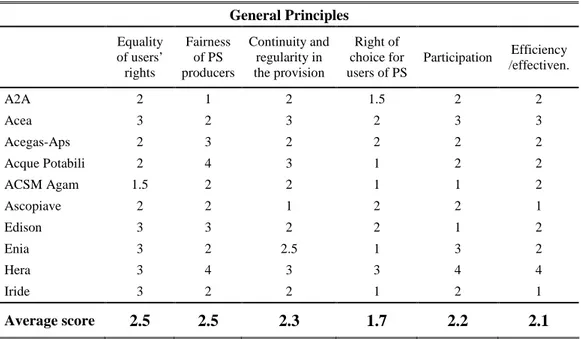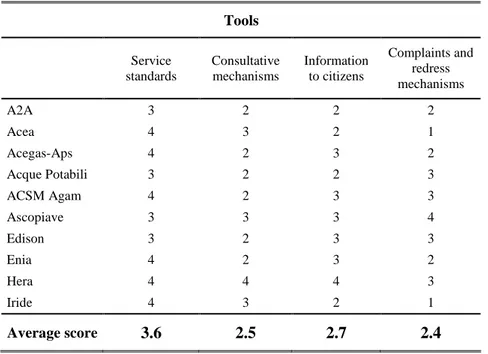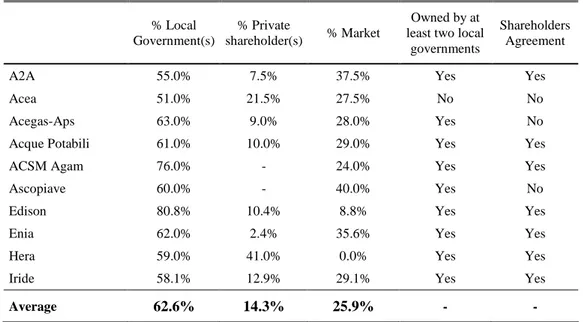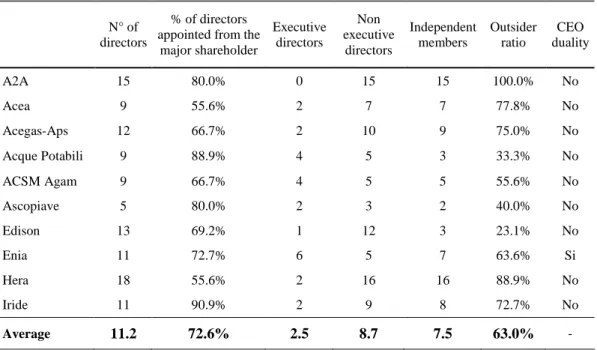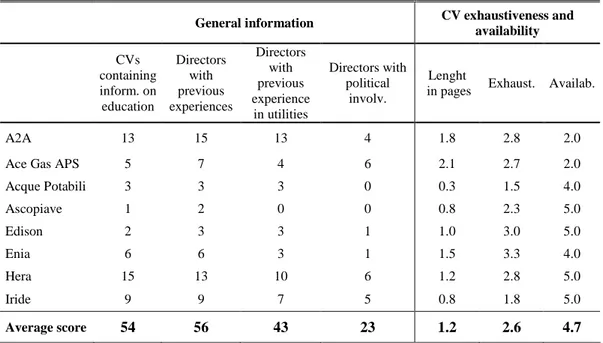University of Rome “Tor Vergata”
Faculty of Economics
PhD in Public Management and Governance (XXII)
G
OVERNANCE
S
TRUCTURES AND
M
ECHANISMS
IN
P
UBLIC
S
ERVICE
O
RGANIZATIONS
:
T
HEORIES
,
E
VIDENCE AND
F
UTURE
D
IRECTIONS
Supervisors: PhD Student:
Prof. Francesco Ranalli Andrea Calabrò
Prof. Morten Huse
Completing this PhD-thesis has been possible due to all the support and encouragement I have received during the course of my doctoral research. Without the support from the Department of Business Studies – University of Rome “Tor Vergata” (Italy), as well as the support from the Department of Innovation and Economic Organization – BI Norwegian School of Management (Oslo, Norway), this project would not have been possible to complete. There are many people I would like to thank.
First of all, I would like to thank my supervisor and PhD Coordinator Professor Francesco Ranalli at the University of Rome “Tor Vergata” for his patience and support. I want to thank him for guiding me throughout the whole research process, and I gratefully acknowledge the help and comments along the way.
I would also like to sincerely thank Professor Morten Huse at BI Norwegian School of Management for acting as my co-supervisor and encouraging me during the entire process. In addition, I would like to thank him especially for his guidance in the international research arena, for his advice, for being a good friend and for his great hospitality in Norway.
I would like to thank Professor Victor Pestoff (Institute for Civil Society Studies – Sweden) for his support on Co-production and New Public Governance.
I would like to express my gratitude to Mariateresa for being always involved in my personal and professional life, for supporting me with great effort and for her patience and encouragement.
This PhD-project, however, has indeed been a project for the whole family. I would like to express my gratitude to my mother Rosa, my father Luigi, my two brothers Antonio and Giuseppe, as well as the rest of my family for their support during this process. I would also like to thank Emiliano for the discussions we had together and for stimulating my research activity. Many thanks also to all my colleagues.
A special thank is for Gabriele for being a good friend and for believing in my ideas and enthusiasm. Many thanks to Diego (DJ) for actively supporting me and for the “American” discussions we used to have. Finally, thanks to all my friends, so many people contributed in different ways to the preparation of this thesis that it will be impossible to list all of them here. I could not have done this without you all!
Introduction
I– Chapter 1 –
G
OVERNANCE STRUCTURES AND MECHANISMS IN PUBLIC SERVICE ORGANIZATION:
A REVIEW AND RESEARCH AGENDA1.1 Introduction and motivation 1
1.2 The theoretical debate on governance structures
and mechanisms in PSOs 5
1.3 Methods 9 1.3.1 Selection of papers 9 1.3.2 Content analysis 12 1.3.3 Type of articles 13 1.3.4 Use of theories 13 1.3.5 Research setting 13 1.3.6 Source of data 14
1.3.7 Governance structures and mechanisms in PSOs 14
1.4 Empirical results 15
1.4.1 The growing attention to the research on governance structures and mechanisms in PSOs 15
1.4.2 Interactions of theories, settings, and data sources 15
1.4.3 Time evolution 20
1.5 Discussion and findings 22
1.6 Conclusions and future research directions 30
1.7 References 31
– Chapter 2 –
C
ONFLICTS OF INTEREST AND GOVERNANCE MECHANISMS INI
TALIANL
OCALP
UBLICU
TILITIES2.1 Foreword 38
2.2 The governance system of LPUs: a principal-agent perspective 40
2.2.1 The agency relationships between the citizens and the main shareholder 42
2.2.2 The principal-principal conflict 44
2.2.3 The role of the board of directors as the main governance mechanism 45
2.5 Discussion and findings 56 2.6 Conclusions and future research directions 62
2.7 References 64
Appendix: The legislative evolution of local public services in Italy 69
– Chapter 3 –
P
ARTIAL PRIVATIZATION PROCESSES AND ACCOUNTABILITY ISSUES:
EVIDENCE FROM
I
TALY ANDN
ORWAY3.1 Introduction 74
3.2 The privatization process in different perspectives: New Public Management, New Public Service, New Public Governance 76 3.3 Privatization, public service providers, corruption and conflict of interest 79
3.4 Methods 82
3.5 Privatization in Italy and in Norway: a historical overview 87
3.5.1 The Italian case 87
3.5.2 The case of Norway 89
3.5.3 Privatization in Italy and in Norway: different drivers but same final status 92
3.5.4 The ethical structure 93
3.6 Discussion and Findings 97
3.7 Conclusion and future research directions 101
3.8 References 104
– Chapter 4 –
D
OES THE BOARD OF DIRECTORS CONTRIBUTE TO THE INNOVATION OFS
TATE-
OWNED COMPANIES?
4.1 Introduction 108
4.2 Why is innovation important for SOCs? 110
4.2.1 The types of innovation in SOCs 111
4.2.2 The Norwegian context and the role of SOCs 114 4.3 Governance mechanisms and innovation in SOCs: the role of the board of directors 116
4.3.1 Board composition and board working style 117
4.6 Discussion and Findings 128 4.7 Conclusions and future research directions 133
4.8 References 135
– Chapter 1 –
Figure 1 – The research on governance structure and mechanisms of PSOs 16
– Chapter 2 –
Figure 1 – The agency relationships in LPUs 43
– Chapter 4 –
– Chapter 1 –
Table 1 – Summary of the selection criteria 16 Table 2 – Overview of journals including publications per time
period and impact factor 17 Table 3 – Interactions of theories, settings, and data sources 18
Table 4 – The evolution of the literature on governance structures
and mechanisms in PSOs 21
– Chapter 2 –
Table 1 – The LPUs listed in the Italian Stock Exchange 48
Table 2 – The content analysis of the service charters (principles) 51
Table 3 – The content analysis of the service charters (implementation actions) 52
Table 4 – The Ownership structure of LPUs 53
Table 5 – The board composition 54
Table 6 – The content analysis of the CVs 55
– Chapter 3 –
Table 1 – Companies owned by the MEF in Italy 84
Table 2 – Companies with sectoral policy objectives in Norway 86
– Chapter 4 –
Table 1 – Companies in the sample 122
Table 2 – Factor analysis of innovation measures 123
Table 3 – Summary Statistics 125
Table 4 – The correlation matrix (88 observations) 127
Public services play a central role in the well-being, sustainability and growth of communities, cities and nations. However, globally, public services have emerged from a period of considerable criticism. This period of challenge to public services was generated by the rise of neo-liberal ideologies in the 1980s and 1990s (Hartely et al., 2008). During this period market solutions were implemented instead of State provisions. Privatizations and disinvestments played a central role in that process (Cafferata, 1993) taken place on the grounds that management is underpinned by certain general principles and practices (New Public Management) which can be applied across a range of businesses, organizations and sectors (Pollit and Bouckaert, 2004).
The current situation is characterized by new forms of relationships between State and society. The role of both government and public services are considered fundamental in order to create stable social and economic conditions by actively involving citizens and community organizations. Therefore, the inter-relationships between the public, the private and the voluntary sectors in the design and provision of public services are increased (Ferlie et al., 2005).
In recent years, two seem to be the key questions: how are public service organizations governed? And, are we asking the right questions? These questions arise from the fact that nowadays, the public sector has differences among countries and many actors are producing and providing public services through different modes of governance. Actually, it is possible that public private partnerships (hereafter denoted as PPPs) (Klijn, 2008), outsourcing, state owned companies, municipal corporations (Grossi and Mussari, 2009; Grossi e Reichard, 2008), third sector and voluntary organizations, citizens, etc. might coexist. However, many issues may arise, for example, from the use of PPPs, co-production with civil society organizations, and other new governance arrangements. These developments open up questions about the extent to which such new organizational forms deliver benefits of innovation, efficiency and responsiveness, as well as their impact on processes of steering and accountability in a democratic
production of public services and goods to citizens however it raises many accountability problems due to the overlapping of roles and responsibility (Skelcher, 2010). This is the major concern of a networked public sector (Rhodes, 2007) and therefore analyses of public service organizations’ (hereafter PSOs) governance systems are needed.
Managing those complex inter-relationships can be harnessed to improve a range of public services by examining them through different theoretical perspectives (e.g. network theories, agency theory, resource and knowledge based theories, political power theories, innovation and change theories, performance and management theories, governance theories, etc.). By using this approach it will be possible to definitely advance both theory and practice, beyond the traditional model of Public Administration (hereafter denoted as PA) and New Public Management (hereafter denoted as NPM), by considering the existence of networked forms of governance, thus arriving at the acceptance of the New Public Governance (hereafter denoted as NPG) as the steering theoretical framework (Osborne, 2006; 2009).
These aspects are in line with the new awareness of the social, economic, and cultural contribution of public services, public organizations and government has resulted in a significant period of reform and experimentation (Hinna et al., 2006). Besides, at the heart of these initiatives is the idea that improvements to the ways in which public services can be governed, managed and delivered will produce improved outcomes for citizens (Brandsen and Pestoff, 2006; Pestoff, 2009).
The purpose of this thesis, therefore, is a new understanding of public service organizations’ (hereafter denoted as PSOs) governance and management. This is done by using a multidisciplinary approach to explore governance structures and mechanisms, management, innovation, and performance of PSOs. Moreover, the study fills the gap of quantitative analysis to be tested and explored for their meanings and contextual influences by undertaking case studies, and for case studies to generate propositions to be tested with large datasets. Finally, questions of when, how and why
governance structures and mechanisms matter to public service performance and accountability, are addressed.
The role of governing bodies and internal governance mechanisms seems to be especially important for understanding the dynamics and the processes that in turn affect the overall value creation capacity of PSOs. In this respect, it is important to underline that PSOs primarily aim to produce not profit or market positioning but “public value” (Moore, 1995; 2005; Bozeman, 2009). Public value means what is added to the public sphere and this may be social or economic, or it may be political, environmental or even more broadly about the quality of life. Indeed, a public value perspective requires examining the impact of public services on “costumers” and “users” but also the impact on them as “citizens”.
Only by taking into account all these issues and the inherent complexity of the analyzed phenomenon, through this study it becomes possible to investigate the governance structures and mechanisms of PSOs from different angles and “regimes”, with emphasis on differences among national contexts, theoretical frameworks, and methods of analysis.
The first chapter is a systematic literature review on governance structures and mechanisms in PSOs. The other chapters are empirical (with qualitative and quantitative methodology of analysis) and are based on different research settings. In particular chapter two is based on the Italian context and the analysis is on 10 listed local public utilities (hereafter denoted as LPUs). The third chapter makes a cross country comparison of the Italian and the Norwegian privatization processes, mainly focusing on the impact of these processes on public service providers. The last chapter is based on Norwegian data (collected from 2003 to 2006) on 88 state owned companies (hereafter denoted as SOCs) mainly operating in the service sector.
The first chapter – “Governance structures and mechanisms in public service organizations: a review and research agenda” – comprises a systematic literature review
governance structures and mechanisms are receiving increasing attention worldwide. However, there are often overlaps, misuse and superficiality when using the term governance. Particularly, the governance term is monopolizing and inhibiting the debate on Public Administration and Management (hereafter denoted as PAM).
The research questions addressed in the chapter are: which are the governance structures and mechanisms used for managing PSOs? Why there is a need for a systematic literature review? How to cope with the gaps? How to contribute to the on-going debate? And, which are the possible future research directions? Therefore, the aim is to assess the state of the art on governance structures and mechanisms in PSOs analysing past, present and future evolutions. We use the argument advanced in Osborne’s article (2006) that PAM has actually passed through three dominant modes [Public Administration, New Public Management and New Public Governance]. Drawing on that classification the chapter analyses quantitatively 184 published journal articles, from 1970 to 2009 by showing the relationships among theories, research settings, sources of data, countries of analysis, governance structures and mechanisms, etc. Moving from what is already done in previous studies, the chapter identifies critical areas that need an insightful introspection in order to suggest useful future research directions.
Chapter two – “Conflicts of interest and governance mechanisms in Italian Local Public Utilities” – analyses the situation of the Italian listed LPUs. The focus is thus on local public services and on the involvement of various actors in their governance system. Through the lens of agency theory, the chapter examines the conflicts of interest that may arise among the different actors (citizens, Local governments, private shareholders, service providers, etc.) involved in the governance of LPUs. The overall research questions are: which is the governance system adopted by the Italian LPUs? Is it possible to catch, whether and to what extent potential conflicts of interest arise among different actors [citizens, LGs, private shareholders and service providers]? If yes, is it possible to prevent and mitigate such governance problems? This chapter summarizes the main results of the multiple case study analysis on 10 Italian listed LPUs identifying different and co-existing situations of conflict of interest among multiple principals and agents. Although governance mechanisms (e.g., the board of directors) have different roles and functions and may prevent and mitigate such conflicts, our findings suggest
that there are a number of problematic issues. First, the effects of ownership structure on board composition and functioning. Second, higher numbers of independent directors do not mean “actual” board independence. Third, the Service Charter as a tool for promoting transparency, accountability and public participation is not yet well implemented. The study contributes to the debate on LPUs suggesting possible developments of agency theory by including forms of citizens’ participation and engagement (co-production).
The third chapter – “Partial privatization processes and accountability issues: evidences from Italy and Norway” – highlights how in the last decades the privatization process has characterized and changed the public sector in many European countries. However, often it ended up with public service providers (organized in the form of joint stock companies) still owned by the State (partial privatizations). The main research questions are: what motivates partial privatizations? And, what are the consequences of partial privatizations for the accountability of public service providers? Are there differences or common patterns when comparing the situation of different countries? By discussing the partial privatizations from different theoretical perspectives – New Public Management (NPS), New Public Service (NPS), and New Public Governance (NPG) – the chapter shows some main problematic issues related to corruption, conflicts of interest and the lack of accountability. While in the NPM the privatization process aims at improving public service providers’ efficiency, if analysed from the NPS perspective it seems to create ethical problems. Moreover, NPG, as co-production, networks and cooperation, offers valid alternatives to privatization focusing more on citizens’ public value and interest. Through a case study analysis the chapter describes the Italian and the Norwegian privatization processes. The results show the stop and go characteristic of the Italian process, the reluctance of the Norwegian government to privatize and the existence, in both countries, of situations in which the Ministries are still the major owners of service providers. Moreover, although the role of Ministerial governance has different development in the analysed countries a common pattern exists in relation to ethical and accountability problems. To investigate those issues a content analysis of codes of ethics has been
governments. Finally, we discuss networked modes of governance and the implementation of accountability as reasonable alternatives to the lacks generated by these partial privatization processes.
In the fourth chapter – “Does the board of directors contribute to the innovation of State owned companies?” – the focus is on the influence of internal governance mechanisms on the innovation of Norwegian SOCs mainly operating in the service sector. The chapter shows that in the broader public services arena, there have been a limited number of studies on innovation in public services (Osborne and Brown, 2005), and that recently an increasing attention has been given to them. Actually, in the wake of the global financial crisis of 2008-2009 many industrialized States worldwide have increased their stakes in corporations, characterizing even more the organization type of SOCs. Therefore, the idea of governments as value-creating institution is increasing and the focus on its main drivers is emerging. Moreover, there has been a great deal of both scholarly and professional interest in “innovation” believing that it is essential to the improvement and effectiveness of the public sector. This chapter seeks to add knowledge on the governance mechanisms in SOCs (and in a more extended view also in other government owned companies) influencing their innovation capacity. In this investigation interesting contribution are given especially by answering the following research questions: is innovation a valuable feature of governance and a useful concept in SOCs? Does the board of directors contribute to the innovation of SOCs? Drawing on the innovation literature, the agency and the resource-based theories, the analysis is on a sample of 88 Norwegian SOCs mainly operating in the service sector. The results show that some aspects of board composition, board working-style and board members’ knowledge and competences influence significantly the type of innovations. Implications for the theory and the practice and future research directions are discussed.
As shown in this brief description, the analysis is mainly focused on two specific contexts: the Italian and the Norwegian one. This choice allows to make cross countries comparisons and to understand how historical evolutions, political contexts, traditions, and national conditions influence theories, research settings, findings and finally knowledge building. In fact, the Italian context has been mainly characterized by reforms
processes that lead now to situations in which nationally and locally there are private law companies (Saraceno, 1988) operating in the production and provision of public services in a context still characterized by low level of competition, despite the continuous European intervention to the creation of a competitive market also for public services. To the contrary, the Norwegian context is characterized by an active role of the State which exercises most of the high value activities for the entire community (Christensen, 2003). Even if the two context are characterized by a high intervention of the State in the economy (with different degrees and tools), substantially, as it is better shown in chapter three and four, they have different patterns and evolving perspectives. However, similarities exist between them and accountability concerns emerge in both the national contexts. Thus, what seems clear is that in the entire context characterized by PSOs there are more stakeholders with a variety of interests (Borgonovi, 2005), and they become even more present and exercising their right to “voice”. The boundaries between PSOs, contexts, and citizens are even more permeable and Public Management studies should thus be oriented in managing this complexity.
More about the overall thesis
Many parts of the thesis have been realized during a research stay at BI Norwegian School of Management, Oslo – Norway. Professor Morten Huse has been the supervisor of the overall activities during the visiting period at BI.
The thesis is developed following the European PhD Label guidelines. The idea of a European Doctorate (European PhD or Doctor Europaeus/ Europaea) originated from an informal initiative in 1991 of the former Confederation of European Union Rectors’ Conferences concerning requirements for the awarding of a “Doctor Europaeus”. In order to get this title the thesis has been developed according to the following guidelines:
1. At least two professors from two higher education institutions of two European countries, other than the one where the thesis is defended, have given their review of the manuscript;
2. At least one member of the jury comes from a higher education institution in another European country, other than the one, where the thesis is defended; 3. A part of the defence takes place in one of the official languages, other than the
4. The thesis must partly have been prepared as a result of a research period of six months spent in another European Country.
The thesis fulfils all these requirements. Two international scholars have reviewed the thesis. Particularly, prof. Morten Huse (BI Norwegian School of Management - Norway) which is president of the European Academy of Management and prof. Victor Pestoff (Institute for Civil Society Studies, Ersta Skondal University College – Sweden) leading scholar in New Public Governance and Co-production. Professor Morten Huse is also one member of the jury coming from a higher education institution other than Italy. The defence is completely in English language. Finally, it has been partially prepared during a research stay (six months) in Oslo (Norway) at BI Norwegian School of Management at the Department of Innovation and Economic Organization.
.
More about the chapters
Previous versions of these chapters have been presented to several National and International Conferences. Moreover, previous versions of these chapters are already published or in publication. Especially, chapter one has been submitted to the international journal Public Management Review.
A previous version of chapter two was awarded as best paper during the IV National Workshop of “Azienda Pubblica” held at the University of Rome “Tre” (25th – 26th of March, 2010) – Italy. This chapter is currently under review at Azienda Pubblica (an Italian journal). Another version of this chapter has been accepted for the XXXIII Annual Conference of AIDEA (Italian Academy of Management) that will be held in Milan (21st – 22nd of October, 2010) at Bocconi University – Italy.
A previous version of chapter three was presented to the “International Workshop on Social Audit, Social Accounting and Accountability”, arranged by the “International Research Society for Public Management” (IRSPM) and by the Third Sector Study Group of European Group for Public Administration (EGPA), at Charles University of Prague (the 15th – 16th of May, 2008). Another version of this chapter, focusing only on the Italian context will be published (2010) in S. P. Osborne and A. Ball (eds.), Social Accounting and Public Management: Accountability for the Public Good, Routledge, London. The current version of chapter three has been accepted for publication in V.
Pestoff, T. Brandsen and B. Verschuere (eds), New Public Governance, the Third Sector and Co-Production, Routledge, London.
Chapter four has been submitted to the international journal Public Money and Management.
References
Borgonovi, E. 2005. Principi e sistemi aziendali per le amministrazioni pubbliche, Egea: Milano.
Bozeman, B. 2009. Public values theory: three big questions. International Journal of Public
Policy, 4(5): 369-375.
Brandsen, T. and Pestoff, V. 2006. Co-production, the third sector and the delivery of public services - An introduction. Public Management Review, 8(4): 493-501.
Cafferata, R. 1993. La società per azioni pubblica. Equilibrio economico e strategie di
transizione. Franco Angeli: Milano.
Christensen, T. 2003. Narratives of Norwegian governance: elaborating the strong state tradition. Public Administratio, 81(1): 163-190.
Ferlie, E., Hartley, J., and Martin, S. 2003. Changing public service organizations: Current perspectives and future prospects. British Journal of Management, 14(1): 1-14.
Hartley, J. Donaldson, C. Skelcher, C. and Wallace, M. 2008. Managing to improve public
services. Cambridge: Cambridge University Press.
Huse, M. 2007. Boards, governance and value creation: The human side of corporate
governance. Cambridge, England: Cambridge University Press Hartley, J. Donaldson, C.
Skelcher, C. and Wallace, M. 2008. Managing to improve public services. Cambridge: Cambridge University Press.
Klijn, E.H. 2008. Governance and governance networks in Europe - An assessment of ten years of research on the theme. Public Management Review, 10(4): 504-524.
Grossi, G. and Reichard. 2008. Municipal Corporatization in Germany and Italy. Public
Management Review, 10(5): 597-617.
Hinna, L., Meneguzzo, M., Mussari, R., Decastri, M. 2006. Economia delle aziende pubbliche. McGraw-Hill: Milano.
Grossi, G. and Mussari, R. 2009. The Effects of Corporatisation on Financial Reporting: The Experience of the Italian Local Governments. International Journal of Public Policy, 4(3-4): 268-282.
Osborne, S. P. 2006. The new public governance? Public Management Review, 8(3): 377-387. Osborne, S. P. 2009. Debate: Delivering public services: Are we asking the right questions?
Public Money and Management, 29(1): 5-7.
Pestoff, V. 2009. Towards a Paradigm of Democratic Participation: Citizen Participation and Co-production of Personal Social Services in Sweden. Annals of Public and Cooperative
Economics, 80(2): 197-224.
Pollitt, C. and Bouckaert, G. 2004. Public Management Reform: A Comparative Analysis. Oxford: Oxford University Press.
Rhodes, R.A.W. 2007. Understanding governance: Ten years on. Organization Studies, 28(8): 1243-1264.
Skelcher, C. 2010. Fishing in Muddy Waters: Principals, Agents, and Democratic Governance in Europe. Journal of Public Administration Research and Theory, 20(1): 161-175.
ORGANIZATIONS
:
A REVIEW AND RESEARCH AGENDAAbstract
Issues related to governance structures and mechanisms in public service organizations are receiving increasing attention worldwide. However, there are often overlaps, misuse and superficiality when using the term governance. Particularly, the governance term is monopolizing and inhibiting the debate on Public Administration and Management. The aim of this systematic literature review is to assess the state of the art on governance structures and mechanisms in public service organizations analysing past, present and future evolutions. We use the argument advanced in Osborne’s article (2006) that Public Administration and Management has actually passed through three dominant modes [Public Administration, New Public Management and New Public Governance]. Drawing on that classification the chapter analyses quantitatively 184 published journal articles, from 1970 to 2009 by showing the relationships among theories, research settings, sources of data, countries of analysis, governance structures and mechanisms, etc. Moving from what is already done in previous studies, the study identifies critical areas that need an insightful introspection in order to suggest useful future research directions.
Keywords: Governance structures; governance mechanisms; public service organizations;
systematic literature review
1.1 Introduction and motivation
Public service organizations (hereafter denoted as PSOs) at all levels have come under increasing pressure from deregulation and the continuous comparison with the private sector. They have made considerable efforts to improve their efficiency, to reduce costs by downsizing and rationalization, by introducing new managerial concepts and tools and by being more responsive to citizens or customers (Pollitt, 2009). Indeed, they are facing competition and an increasing demand for privatization for many reasons (Boyne, 2003) especially because they suffer from long lasting fiscal stress (Stiglizt,
2002. All those different influences are forcing PSOs to adapt to the new challenges and conditions (Reichard, 2006). One particular aspect has been to be more open to external market pressures and to accept market mechanisms and competitive arrangements as a challenge, which in an increasingly competitive environment might contribute to their survival (Reichard, 2006).
In the past 10 years, serious challenge to the ideal of Public Administration (hereafter denoted as PA) has been mounted by critics and reformers who favour market, network, or mixed-economy models (Considine and Lewis, 2003). Indeed, theories of democratic government traditionally have relied on a model of organization in which officials act impartially, accept clear lines of accountability and supervision, and define their day-by-day activities through rules, procedures, and confined discretion. However, recently networked forms of governance are seen as particularly well suited to meet the challenges of increased differentiation compared to the centralized, slow and rigid hierarchies as well as to the anarchy of the market (Esmark, 2009). There is also an emerging idea highlighting that PSOs are once more seen as interesting and important sites of study and not merely as a residual category to be considered after the analysis of the private sector has been exhausted (Ferlie et al., 2003). All those aspects are associated with an increasing and larger cultural contest over the importance of terms such as “public interest”, “public value” that in this new century need to be better understood (Alford and Hughes, 2008; Perry, 2007). Thus, the aspects of locally accessible and accountable public services seem to become fundamental (Jorgensen and Bozeman, 2007;Bozeman, 2009).
The main issues are related to the evolution of different ways of public services provision during the years (Cafferata, 1995; 2008). Indeed, PSOs have experienced and are experiencing many changes in how to govern complex public services production and/or provision. The citizens become more and more informed and the ICT development completely changes the way we understand public services (Torres et al., 2005). Therefore, the investigation of the governance structures and mechanisms helps to be aware of the current national and international patterns and to carry out possible future directions in the area. By assessing the relevant literature on the topic it will be
possible to develop knowledge building in order to understand drivers, causes and effects of PSOs’ strategic choices (Boyne and Walker, 2004).
We use the argument that Public Administration and Management (hereafter denoted as PAM) has actually passed through three dominant modes – a longer, pre-eminent one of PA, from the late nineteenth century through to the late 1970s/early 1980s; a second mode, of the New Public Management (hereafter denoted as NPM), through to the start of the twenty-first century; and an emergent third one, of the New Public Governance (hereafter denoted as NPG), since then (Osborne, 2006). This three-stage model is a simplification; certainly elements of each stage can often coexist with each other or overlap (Osborne, 2006). Actually, many network systems often operate in the shadow of, or in spite of, the dominant mode of hierarchy, for example, while both PA and NPM contain strong, if differentiated, elements of hierarchy (Klijn, 2008). Drawing on this classification the chapter quantitatively analyses 184 published articles (from 1970 to 2009). The aim of this systematic literature review is to tease out the status quo of governance structures and mechanisms in PSOs. This will assist and promote analyses and discussions of the conceptual and practical development of PAM also outlining further research developments.
Stemming from this framework we would like to answer the following research questions: which are the governance structures and mechanisms used for managing PSOs? Why there is a need for a systematic literature review? How to cope with the gaps? How to contribute to the on-going debate? And, which are the possible future research directions?
In order to answer these questions a sample of published journal articles on this topic was identified using an adapted version of the approach developed by David and Han (2004) and Newbert (2007). This method differs from the traditional narrative review by being more systematic and explicit in the selection of published journal articles and by employing quantitative evaluations. Synthesizing existing evidence in this way can be a powerful tool for build up knowledge, and can be as important as conducting new research (Light and Pillemer, 1984).
The database Econlit, Web of science (ISI)1, ABI Inform and Elsevier Science Direct are selected in order to search for all scholarly articles containing simultaneously the keywords ["public servic*2" and govern*] or [“public servic*” and privat* or state or municipal* or partnership or utilit* or ppp* or network* or local or co-product* or citizen* or partecipat* or democra*] in the title or in the abstract. The time period is from 1970 to 2009. Essentially, from all the published journal articles a representative sample of 184 analyzing governance structures and mechanisms in PSOs has been extracted.
The main results from the systematic review highlight existing patterns among the theories, the research settings, the sources of data, the governance structures and mechanisms, etc.
The contribution of the paper is threefold.
First, it helps overcoming the implicit limit of much PAM research that has been small scale, undertheorized and has been focused on application rather than theory building (Ferlie et al., 2003). By assessing the relevant literature on the evolution of governance structures and mechanisms in PSOs it is possible to be aware of the status quo and the future research directions.
Second, it quantitatively shows that the analyzed articles are classifiable following Osborne’s (2006) arguments. Actually, these findings are in line with the discussion on the emergence of the NPG and on the shift to Public Management.
Third, by discussing the way research questions, theories, settings, and sources of data interact, the chapter clearly highlights the relationships between those elements and governance structures and mechanisms evolution in PSOs. Moreover, the role of the national context is important as it is also shown by the recent tendency of most empirical studies to be drawn on multiple contexts non-including UK and/or US. There is also an increasing use of surveys in respect to the studies on NPM mainly using archival data.
1 The keywords are searched in the title and in the “topic” instead of the abstract. Moreover, we included
journals directly linked to social science (in particular with PA).
The rest of the paper is organized as follows: in the next section the debate on governance structures and mechanisms in PSOs is presented. In section three, the systematic literature review is described. The main results from the statistical analyses are presented in section four. In the fifth section the results were discussed and the main findings highlighted. Concluding remarks and future research directions are presented in the last section.
1.2 The theoretical debate on governance structures and mechanisms in PSOs When approaching the debate on the importance of public services and PSOs, the application of organization and management theories and the design of organizational research need to be contextualized and take into account social, economic and political factors to be directly relevant to the specific institutional context (Pettigrew, 2005).
PSOs are critical to national competitiveness in creating the necessary conditions and infrastructure (Hartley et al., 2008), in leading and governing local communities and managing complex interrelationships between the State, the market and the civil society (Benington, 2000). The scale of PSOs is also important. Indeed, public services account for over a third of GDP (gross domestic product) in OECD countries (Pettigrew, 2005). However, the management of PSOs is often distinct from other type of organizations, because it operates in a complex policy and political environment, under the formal control of politicians, and is subject to a high degree of scrutiny and accountability (Ferlie et al., 2003). Indeed, PSOs do not aim to make profit but public value for citizens and communities (Bozeman, 2009), as well as balancing competing stakeholder interests (Moore, 1995). Therefore, there is a different relationship between ideas, practices and organizations in the public and private sectors (Moore and Hartley, 2008). That is probably due to the fact that the purpose, drivers, catalysts and key actors are different between sectors (Hartley, 2005; O'Toole et al., 2005).
The general tone of specialist opinion in most parts of the world is now agnostic on what are the best organizational arrangements for PSOs (Osborne, 2009; Skelcher, 2010). There is much agreement that monopolistic provision entirely through state
agencies is unfeasible, undesirable, or simply rather old fashioned (Joshi and Moore, 2004). However, there is little consensus on alternatives. That is why the NPM agenda of privatization and contracting out of public service delivery still has a great deal of support, and even sceptics see in it many elements and ideas of value (Hood et al., 2008). Whatever, it has now been sufficiently road tested that some major flaws and contradictions have become evident (Joshi and Moore, 2004). Anyone now suggests that the dominant language is of pragmatism, pluralism, and adaptation to specific circumstances (Pollitt, 2009; Rhodes, 2007).
Social science literature identifies three pure routes to governance – hierarchy, markets and networks (Thompson et al., 1991) providing a useful starting point for the analysis of the recent history of public service delivery. This point of view is also better explained in Osborne (2006) who clearly identifies the core distinction and time evolution from PA, to NPM and to NPG at the end.
Up to the end of the 1970s hierarchy was the dominant route to the delivery of public services, with intra-agency co-ordination achieved through the distinctive features of bureaucracy, vertical integration, clearly spheres of authority, command-and-control leadership, the emphasis on rules, routines and procedures (Ranade and Hudson, 2003)3. In the 1980s and 1990s the perceived failings of bureaucracy led to a renewed emphasis on markets and competition in the delivery of public services. Conservative governments privatized large parts of the public sector, and exposed what was left to market disciplines through quasi-markets, compulsory competitive tendering, market testing and so on (Snape and Taylor, 2004). Large multi-functional bureaucracies were broken-up into a network of specialised agencies contracting for services with a variety of public, private and voluntary providers. However, in the public sector, the introduction of competition proved to be a problematic exercise for many reasons (Ranade and Hudson, 2003; Robinson, 2007) and always co-existed with strong hierarchical controls downwards from the central government, notably in setting and
3
However, it seems important to underline that since the end of the 1970s, alternatives to internal government production of public services have assumed increasing prominence. The most important of
regulating the performance targets expected from actors in the market (Ranade and Hudson, 2003).
The result was that the break-up of bureaucracies introduced more actors into the policy arena, making co-ordination and a holistic approach to service delivery more difficult rather than less (Hudson and Lowe, 2004). Strategically this fragmentation also made the whole system more difficult to steer in any coherent direction. It was argued that competition and the contract culture had promoted self-interested behaviour rather than the public interest (Bozeman, 2009), and low trust relationships rather than high trust (Ranade and Hudson, 2003).
Hence, by the late 1990s, and partly as a response to these issues, the emphasis changed to networked governance and partnerships as the dominant mode of coordination (Klijn, 2008; Osborne, 2006; 2009; Pestoff, 2009; Ranade and Hudson, 2003).
Giving more complexity to the debate, it is also important to underline that it is difficult (but, could be useful) to distinguish between public services and public sector because of the uncertainty of the boundaries of these concepts (Meier, 2007). What are public services? It is easy to think about some examples: in many countries, law enforcement, refuse collection, utilities outcomes, and primary education would be regarded as public services. Health services may be included, too, but patterns of provision differ. Public services are not necessarily financed and delivered by the public sector, although the public sector is likely to be involved in some way (Grout and Stevens, 2003). We define a public service as any service provided for large numbers of citizens, in which there is a potential significant market failure (broadly interpreted to include equity as well as efficiency) justifying government involvement in production, finance, or regulation (Grout and Stevens, 2003).
The public sector comprises the economic activities controlled by the government, many of which are public services. A particular concern is that PSOs, not subject to the discipline of the competitive market, may lack incentives to control costs or provide quality of service and respond to the needs of consumers (citizens). PSOs may also have multiple and non-financial objectives reflected by the inclusion of all aspects of performance within the definitions (Hodges et al.,1996). The current developments in the study of PSOs, is timely given the recent and current high-level political, policy and
scholarly interest across a large number of countries in strategies of public management reform (Ferlie et al., 2003).
As seen in the picture outlined by Osborne (2006), new modes of governing are evolving with a high degree of autonomy from the State, the so-called governing without government (Rhodes, 2007). However, there are those arguing that it is more appropriate to speak of a shifting than a shrinking role of the State (Kooiman, 1999). The role of the State is transforming from being based on constitutional power towards functioning as a facilitator and cooperative partner (Hysing, 2009; Lundqvist, 2001; Sorensen, 2006; Pierre, 2009).
Governance and government can be regarded as two poles on a continuum along which the role of the State varies from direct State intervention, that is, State governing through authoritative allocation of values to society, to extensive societal autonomy, that is, self-organized and self-governing private and voluntary actors and networks capable of resisting government interference (Rhodes, 1997; Treib et al., 2007). Nevertheless, the major problem with any framework to deliver public services is that those delivering the services can have far better information than the government (Grout and Stevens, 2003). This disparity allows them to pursue goals that may not fully coincide with society's objectives. It is essential to understand how to design activities to elicit correct information from agents responsible for delivery, and to put in place structures so that the incentives facing the agents coincide with society's objectives (Lane, 2005). Of course, this is far from easy!
What seems clear is that the NPM has become perceived as limited and one-dimensional in its ability to capture and contribute to the management and governance of public services and of PSOs – whether situated in the public, private or voluntary sector – in an increasingly plural and pluralist world (Rhodes, 1997; 2007).
Before describing and showing the methods and main results of the systematic literature review, the central tenets and the on-going debate of governance structures and mechanisms in PSOs have been first briefly outlined.
The chapter clearly keeps in mind that PSOs are not like private sector organizations, and for that reason they should not be treated like business entities. So basically theorizing on the public sector management, its services and its organizations should not take business science’s functional areas as a mirror image at all (Kooiman, 1996). Moreover, public sector “corporate governance” distinguishes itself from its private sector counterpart by the considerable diversity of objectives and management structures in the former. There is a need to address performance as well as conformance issues in public sector governance (Hodges et al., 1996). The main open issue is that the structural changes that have characterized the public sector, as the private sector, have been accompanied by cases which have increased public concern over the governance and accountability of PSOs (Hodges et al., 1996; Mulgan, 2006; Poulsen, 2009).
1.3Methods
1.3.1 Selection of papers
The systematic literature review differs from the traditional narrative one by being more systematic and explicit in the selection of published journal articles. It also employs quantitative methods of evaluation. Synthesizing existing evidence in this way can be a powerful tool in building up knowledge, and can be as important as conducting new research (Cooper, 1989; David and Han, 2004; Light and Pillemer, 1984;). The aim is to identify a representative sample of published journal articles (papers) and to test statistically the core tenets of governance structure and mechanisms in PSOs.
In order to assess the research, the sample was identified using an adapted version of the approach developed by David and Han (2004) and by Newbert (2007). This approach was chosen as it represents a more objective approach thereby mitigating some of the bias result when samples are selected via purely subjective criteria (Newbert, 2007). Systematic reviews in the social sciences are relatively new (Rashman et al., 2009; Greenhalgh et al., 2004; Pittaway et al., 2004). The method was first developed in the medical sciences as part of the search for a better evidence base for policy-making and for clinical practice (Tranfield et al., 2003). They have been used in a range of health, social care and educational fields in order to synthesize research in an orderly and transparent way (Boaz et al., 1999; Davies et al., 2000). The chapter adopts some main
elements of the orthodox methodology of systematic review. These include a commitment to make the literature review replicable, scientific and transparent (Tranfield et al. 2003), and establishing a number of steps to frame the enquiry and present the results. Moreover, the emphasis is on the quantitative analysis of articles useful to the elucidation of concepts and frameworks, but also to provide conceptual clarity and the identification of areas where knowledge is still lacking.
Here below follows an adapted version [from David and Han (2004) and Newbert (2007)] showing the main criteria been used:
1. Search for published journal articles only. The time frame is 1970-2009. 2. The database Econlit, Web of Science (ISI), ABI Inform and Elsevier Science
Direct were selected in order to search for all published journal articles (papers) containing simultaneously the keywords ["public servic*" and govern*] or [“public servic*” and privat* or state or municipal* or partnership or utilit* or ppp* or network* or local or co-product* or citizen* or partecipat* or democra*] in the title or in the abstract. This approach enabled us to identify a set of articles directly referring to the debate on governance structures and mechanisms in PSOs. This procedure resulted in 3,809 hits in total.
3. Deletion of duplicate articles (18.0%) found in many databases4.
4. Eliminate substantively irrelevant articles (17.0%) by only selecting articles that appear in journals in which multiple articles appear.
5. Ensure substantive and empirical relevance by reading all remaining abstracts for substantive context [i.e., aligned with the core tenets of the research questions]. In this step the 51.0% of the selected papers were deleted.
6. Further ensure substantive and empirical relevance by reading all remaining articles (563 articles – 15.0%) in their entirety for substantive context (i.e., the articles referring to governance structures and mechanisms).
7. Consolidate results from the electronic sources by including only the articles (184) relevant for the research questions.
184 articles (5.0%) turned out to be relevant to the examination. In sum, the final sample consists of 184 articles published in 33 journals from 1984 (first included paper) to 2009. The large difference between the number of hits (3,809) and the number of included articles (184) is due to several factors. For example, by using four databases the 18.0% of the articles duplicate and have been deleted from the original sample. Moreover, another 17.0% has been deleted following the criterion four (substantive). Finally, in the Web of Science (ISI) database we used different research criteria that lead to a wider number of selected articles. As appeared in the list of criteria, several choices needed to be done.
The first was to include only published journal articles, thereby excluding book chapters or unpublished work. Journal articles have been through a review process that acts as a screen for quality, allowing us to distil studies meeting a certain level of conceptual and methodological rigor. Actually, restricting a review to published studies may enhance quality control having most refereed journals reasonably strict requirements for publication and thus leading to a better technical product (Light and Pillemer, 1984). Furthermore, many electronic abstracting services cover only journals, making other sources much more difficult to locate systematically. Excluding unpublished work may lead to an overestimation of effects due to bias towards publishing significant results. However, some scholars shown that the results of published and unpublished studies were “essentially identical” and that there exists “no problem of availability bias” when including only published works (Hunter and Schmidt, 1990). In addition, it is argued that relying on published results is appropriate when the published research contains several dozen, or in some cases several hundred, relevant works (Cooper, 1989). In such an instance it is likely that while the published research may overestimate the magnitude of the relation, it probably will not incorrectly identify relation direction. Because, as we will explain below, we are not concerned with establishing the direction of effects, we are less concerned about the (possibly negligible) bias introduced by sampling only from published studies.
The second choice was to use different databases (four) in order to have a complete source of articles from which build the final sample. To our knowledge this is the first systematic literature review that uses four different sources.
The third choice was to use more keywords for the research. In particular basing on the existing knowledge on the phenomena of governance structures and mechanisms in PSOs and focusing on the on-going debate the aim is to identify and clustery different approaches and developments in this area.
The fourth choice was to use the EndNote software in order to manage electronically the selected articles. Through this software it has been possible to automatically delete the duplicates in an early stage on the review process. This is also an advancement in comparison to previous systematic review of the literature (David and Han, 2004; Newbert, 2007).
1.3.2 Content analysis
In order to analyze the evolving nature of studies on governance structures and mechanisms in PSOs, two researchers independently analyzed and coded the set of 184 articles (Coffey and Atkinson, 1996; Krippendorff, 2005; Pugliese et al., 2009). The two researchers were asked to codify all basic elements of an article: (a) the type; (b) main research topic; (c) use of theories; (d) research setting; (e) source of data; and (f) the type of governance structures [hierarchy, market (contracting-out, municipal corporations), network (PPPs, co-production, third sector involvement)]. The coding scheme was pre-tested on two sub-samples of 30 articles after which the researchers came to an agreement about the final set of items to be used in the classification for each category (Pugliese et al., 2009). A review was then conducted on the whole set of articles (D’Aveni and Mac-Millan, 1994). At the end of the coding procedure, the two sets of data were matched. There appeared to be a high degree of overlap in the responses – only 43 out of 716 items were coded differently by the two researchers. Inter-rater reliability scores were calculated, and the percent age of agreement (89.3 %) and Cohen’s Kappa (.89) were both above the acceptance threshold (Cohen, 1960; Dewey, 1983). A final meeting was arranged to discuss the inconsistencies in the responses. To reconcile the disagreements, the articles were re-read and recoded (Pugliese et al., 2009).
1.3.3 Type of articles
The 184 articles were differentiated according to their nature – “conceptual” versus “empirical” (Pugliese et al., 2009). Papers were coded as “conceptual” when they sought to advance or refine theory and were solely based on deductive reasoning without any empirical metrics. The articles were labelled “empirical” if authors applied inductive logics, described their methods in a separate section, and argued on the strength of data obtained from qualitative research methods (i.e., interviews, participant observation, and anecdotes) and/or quantitative methods (i.e., archival data and surveys).
1.3.4 Use of theories
To examine the theoretical development of the field, we mapped the theories to which each article explicitly referred. Basing on the contribution of Osborne (2006) we decided to create a variable capturing whether a paper referred to:
1. Political studies (PA)
2. Neo-classical economics and rational/public choice theory (NPM) 3. Organizational sociology and network theory (NPG)
1.3.5 Research Setting
Institutional contexts widely vary between nations and have a profound impact on local governance structures and practices (Pollitt and Bouckaert, 2004). Therefore, an important dimension of the analysis is added by examining the empirical setting in which research on governance structures and mechanisms in PSOs has been conducted. As most empirical articles in our sample are based on UK and US data, we decided to use the following categorizations (Pugliese et al., 2009):
1. Articles using exclusively data drawn from the UK 2. Articles using exclusively data drawn from the US
3. Articles using data based on multiple setting (including also UK and/or US) 4. Articles using data based on multiple setting (non including neither UK nor US)
1.3.6 Source of data
To provide insights in the use of different data sources, we coded the empirical articles with the following six categories (Pugliese et al., 2009):
1. Interviews
2. Anecdotal evidence 3. Archival data 4. Survey data
5. Direct observations
6. Multiple sources (combinations of the above-mentioned sources)5
1.3.7 Governance structures and mechanisms in PSOs
When analysing the different governance structures and mechanisms in PSOs, the main issues are related to the evolution of different ways of public services production/provision during the years (Cafferata, 1993). Therefore, the investigation of the governance structures and mechanisms helps to be aware of the current national and international patterns and to carry out possible future research directions in the area. Drawing from Osborne (2006) that suggest that PAM has actually passed through three dominant modes PA, NPM, and NPG, we use this three-stage model as a simplification (knowing that elements of each stage can often coexist with each other or overlap). The first group includes the hierarchy as a qualifying aspect of the governance structure of PSOs. The second group investigates the market as a qualifying aspect of the governance structure of PSOs. Particularly, we identify contracting-out (Brown et al., 2006; Hood, 1997; Yang et al., 2009) and Municipal corporations (Grossi and Mussari, 2009; Grossi and Reichard, 2008) as ways to improve efficiency and effectiveness in PSOs. The third group encompasses research that explores networked forms of governance in PSOs. This group includes the articles referring directly to the network (Klijn, 2008; Klijn et al., 1995) structure as the main mechanisms used for public service production and provision. Moreover, there are public-private partnerships (PPPs) (Fischbacher and Beaumont, 2003; Hood and McGarvey, 2002; Klijn and Teisman, 2003; Warner and Hefetz, 2008), co-production considering the importance of citizens engagement and
involvement in the governance of public services (Alford, 1998; Bovaird, 2007; Brandsen and Pestoff, 2006; Pestoff, 2009), and finally the involvement of Not for profit and voluntary organizations (Chew and Osborne, 2009; Considine, 2003; Osborne, 1998; Osborne et al, 2008).
1.4Empirical results
1.4.1 The growing attention to the research on governance structures and mechanisms in PSOs
This section provides a brief overview of the main results from the systematic literature review using tables, matrix and other explanatory tools. The aim is to give more clarity to the overall picture as resulting from the analysis. Table 1 shows for each step (from step 1 to 6) the number of articles returned from the systematic review process. The final sample is of 184 published articles.
In recent years, many scholars have debated the various governance structures and mechanisms in PSOs (Hartley et al., 2008). Figure 1 illustrates the historical development of the number of published articles on this topic in the PAM literature. As depicted, the first paper was published in 1984, and in the following decades the number of published articles steadily increased. Studies on governance structure and mechanisms were published irregularly during the early years prior to the ‘90s. Since then, the marked increase in the average number of articles on the topic reflecting the growing attention of scholars.
Finally, it is noteworthy that in the period 2001–2009 (Table 2) most papers were published in top journals on PAM, such as Public Administration (29), Public Money and Management (28), Australian Journal of Public Administration (15), Public Administration Review (14), Public Management Review (12), and Journal of Public Administration Research and Theory (10).
1.4.2 Interactions of theories, settings, and data sources
Table 3 provides an overview of the articles that have contributed to the growing attention on governance structure and mechanisms of PSOs. The papers are overwhelmingly empirical (N = 132; 72 per cent).
Table 1 – Summary of the selection criteria6 Database Filter type Description
Econlit Web of Science (ISI) Elsevier Science Direct ABI Inform Total 1 Substantive
All articles with ["public servic* " and govern*] or [“public servic*” and privat* or state or municipal* or partnership or utilit* or ppp* or network* or local or co-product* or citizen* or partecipat* or democra*] in title or abstract
815 1976 490 528 3809
2 Duplicates Deletion of duplicate articles
found in both databases 668 3141
3 Substantive
Eliminate substantively irrelevant articles by only selecting articles that appear in journals in which multiple articles appear
635 2506
4 Substantive
Eliminate abstracts read that are not relevant for the research question
1943 563
5 Substantive
Eliminate full articles read not relevant for the research questions
379 184
6 Substantive Final number of articles included
in the review 184
Source – Our elaboration
Figure 1 – The research on governance structure and mechanisms of PSOs
0 5 10 15 20 25 30 1984 1988 1992 1996 2000 2005 2009 Years N . p a p e rs
Source – Our elaboration
Table 2 – Overview of journals including publications per time period and impact factor Journal On-line starting from Impact Factor 1980-1991 1992-2000 2001-2010 Overall 1 Public Administration 1923 1.269 4 3 22 29
2 Public Money and Management 1981 0.438 2 10 16 28
3 Australian Journal of Public Admin. 1937 0.59 4 7 4 15
4 Public Administration Review 2000 1.503 0 1 13 14
5 Public Management Review 1999 0.93 0 1 11 12
6 J. of Public Admin. Res. and Theory 1991 1.509 0 2 8 10
7 Government Information Quarterly 1984 1.91 3 2 2 7
8 Intern.l Review of Admin. Sciences 1957 0.71 3 1 3 7
9 Administration and Society 1969 0.941 3 1 2 6
10 American Review of Public Admin. 1967 0.633 2 2 2 6
11 Policy and Politics 1973 0 3 0 3 6
12 Annals of Public & Coop. Economics 1925 0 0 1 4 5
13 Local Government Studies 1975 0.514 1 2 3 6
14 Gov.: An Int. J. of Pol., Adm., Instit. 1988 1.137 1 2 1 4
15 Journal of Urban Affairs 1979 1.271 3 1 0 4
16 Public Choice 1966 0.698 3 1 0 4
17 Journal of Management Studies 1964 2.558 1 1 1 3
18 Australian Jour. of Political Science 1970 0.461 0 1 1 2
19 Accoun., Auditing and Account. Jour. 1988 0 0 0 1 1
20 British Journal of Management 1990 1.839 0 0 1 1
21 Inter. Journal of Public Administr. 1979 0 0 0 1 1
22 International Journal of Public Policy 1986 0 0 0 1 1
23 Intern. J.l of Public Sector Manag. 1988 0 0 1 0 1
24 Intern. Journal of Social Welfare 1992 0.631 0 1 0 1
25 Intern. Review of Applied Economics 1987 0 0 0 1 1
26 Organization Studies 1980 1.857 0 0 1 1
27 Oxford Review of Economic Policy 1985 0.642 0 0 1 1
28 Policy Studies 1980 0 0 0 1 1
29 Political Research Quarterly 1948 0.75 0 0 1 1
30 Public Budgeting and Finance 1981 0 0 0 1 1
31 Public Organization Review 2001 0 0 0 1 1
32 Social Policy and Administration 1967 0 0 0 1 1
33 Urban Affairs Review 1965 0.186 0 0 2 2
33 41 110 184
